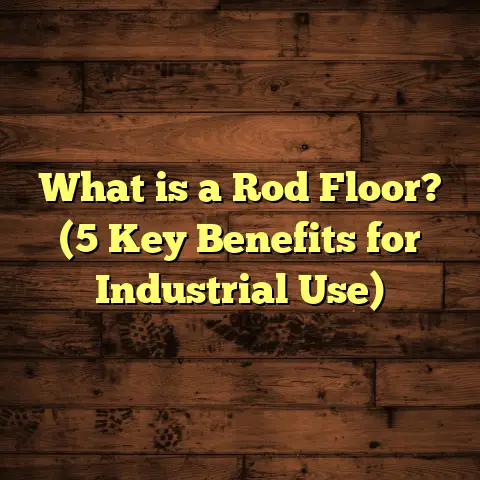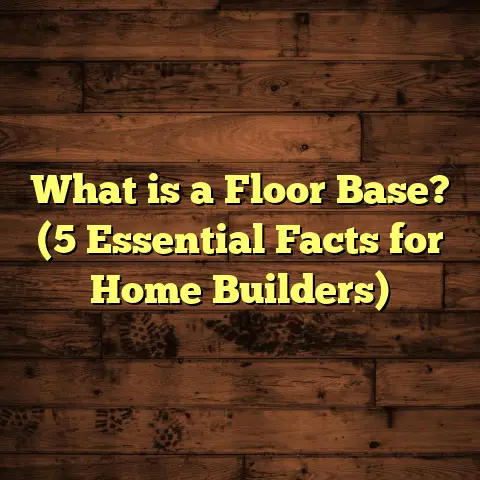What is Better: Tiles or Vinyl Flooring? (5 Key Comparisons)
What is Tiles and Vinyl Flooring?
Before we dive into the nitty-gritty details, let’s make sure we’re on the same page about what tiles and vinyl flooring actually are. Understanding these basics will help you follow along as I share my experiences and insights.
Tiles are solid flooring pieces crafted from materials like ceramic, porcelain, or natural stone such as marble or granite. These materials are fired or cut to create flat, durable pieces that can be fitted together to cover a floor. Tiles have been used for centuries in homes, public spaces, and commercial buildings because of their durability and aesthetic appeal.
Ceramic tiles are made from clay and other natural materials, then glazed to add color or texture. Porcelain tiles are a type of ceramic but denser and less porous, making them more water-resistant and tougher. Natural stone tiles offer unique patterns since they come straight from quarries, but they require more care.
On the other side, vinyl flooring is a synthetic product primarily made from polyvinyl chloride (PVC). It comes in sheets, tiles, or planks, and its manufacturing process allows it to mimic the look of wood, stone, or even tile. In recent years, vinyl has evolved from cheap linoleum-like flooring to a high-quality option called luxury vinyl tile (LVT) or luxury vinyl plank (LVP).
Vinyl’s flexibility means it can be installed over many kinds of surfaces without much fuss. It’s softer underfoot than tile and tends to feel warmer. It’s often used in areas where water resistance and comfort matter but budgets or installation speed limit options.
I learned the difference the hard way early in my career when I took on my first flooring project for a friend’s kitchen remodel. They wanted something durable but affordable, so we debated between porcelain tile and vinyl plank flooring. The choice wasn’t simple because each had pros and cons depending on how they’d use the space. That experience sparked my interest in understanding these materials deeply.
1. Installation and Ease of Use
Tiles: A Labor of Precision
Installing tiles is an art and a science. I won’t sugarcoat it—tile installation can be a demanding process requiring skill, patience, and attention to detail. When I first tried it out myself, I underestimated how meticulous the work would be.
The subfloor has to be perfectly flat and clean because any bumps or dips can cause tiles to crack later. You have to spread adhesive evenly and set each tile with precision. Spacing is crucial so grout lines stay consistent. After laying the tiles, you apply grout between them, which must be carefully cleaned off before it dries.
Depending on the room size and your skill level, installation can take several days. For example, I once helped a client install 500 square feet of porcelain tile in their bathroom and kitchen over a 5-day stretch. We had to wait for adhesive and grout to cure properly before moving on to the next step.
If you’re DIY-minded, small ceramic tiles can be manageable with patience and basic tools. But large-format tiles or natural stone require professional skills to avoid costly mistakes.
Vinyl: Friendly for DIY and Fast Installations
When it comes to ease of installation, vinyl flooring wins hands down. Many vinyl products come as interlocking planks or peel-and-stick tiles that you can install yourself with minimal tools.
I remember installing vinyl planks in a rental property kitchen where time was tight between tenants moving out and new ones moving in. The entire floor went down in two days with just a utility knife, tape measure, and tapping block.
Vinyl’s flexibility means minor subfloor imperfections don’t need perfect leveling like tiles do. That saves time and frustration.
Even if you hire a pro, vinyl installation usually costs less because it’s faster. On average, vinyl can be installed two to three times faster than tile.
Case Study: Installation Time Comparison
I tracked time for two similar-sized projects recently: one with porcelain tile installation (700 sq ft) and one with luxury vinyl plank (LVP) (650 sq ft).
| Flooring Type | Installation Time (Days) | Crew Size | Notes |
|---|---|---|---|
| Porcelain Tile | 7 | 3 | Subfloor prep + adhesive + grout |
| Luxury Vinyl Plank | 2 | 2 | Click-lock planks; minimal prep |
The tile project took over three times longer and required more labor hours overall.
2. Durability and Maintenance
Tiles: Built to Last Decades
One of the reasons I recommend tiles is their incredible durability. If installed correctly, tile floors can last 20-30 years or more without needing replacement. That’s especially true for porcelain tiles which absorb very little water (less than 0.5%), making them resistant to cracks caused by moisture.
Tiles resist scratches better than vinyl or wood floors. This makes them great for high-traffic areas like kitchens, hallways, or entryways.
I had a client who installed ceramic tiles in their home’s main hallway 25 years ago. The floor still looks great today with only minor grout discoloration that was easily cleaned.
Maintenance Challenges with Tiles
While tiles themselves hold up well, grout lines can be a pain point for maintenance. Grout is porous and can absorb dirt, oils, and moisture that cause stains or mold growth over time.
Regular cleaning involves scrubbing grout lines with specialized cleaners or sealing grout every few years to protect it. Some homeowners hire professional grout cleaning services annually.
I’ve seen many clients frustrated by grout upkeep after a few years. If you don’t maintain grout properly, your beautiful tile floor can start looking dull or dirty despite your best efforts.
Vinyl: Durable but More Vulnerable
Vinyl flooring offers good durability but generally less than tile. High-quality LVP or LVT can last 10-20 years depending on wear and tear.
Vinyl resists water well due to its non-porous surface—making it suitable for bathrooms or basements. However, cheaper vinyl products may crack or fade after heavy use or exposure to sunlight.
Vinyl scratches easier than tile but minor scratches can sometimes be buffed out or covered with repair kits.
Maintenance is simple: sweep regularly and mop with mild cleaners. No grout lines to worry about means less elbow grease.
One family I worked with chose vinyl for their kid’s playroom because spills wiped up in seconds without staining.
3. Cost Analysis
How Costs Add Up
Budgeting flooring projects can be tricky without accurate estimates. That’s where I rely on FloorTally—a tool that helps me calculate total costs including material prices based on local suppliers, labor rates for installers in my area, and even waste percentages to avoid ordering too much or too little.
Let me share some typical cost ranges I’ve encountered:
| Flooring Type | Material Cost per Sq Ft | Installation Cost per Sq Ft | Total Installed Cost per Sq Ft |
|---|---|---|---|
| Ceramic Tile | $2 – $5 | $3 – $7 | $5 – $12 |
| Porcelain Tile | $3 – $8 | $5 – $10 | $8 – $18 |
| Vinyl (LVP/LVT) | $2 – $5 | $1 – $3 | $3 – $8 |
Vinyl flooring is generally less expensive upfront both for materials and installation labor.
Real Project Budgeting Using FloorTally
I recently used FloorTally for a client remodeling their kitchen (approx. 300 sq ft). They were torn between porcelain tile and luxury vinyl plank.
- For tile: FloorTally estimated total cost around $4,200 based on local prices.
- For vinyl: Estimate was $1,800 for high-quality LVP including installation.
This helped the client clearly see the cost difference alongside other factors like durability and design preferences before making their decision.
Hidden Costs You Should Know About
Tiles sometimes require additional expenses beyond installation:
- Subfloor leveling or repairs
- Grout sealing
- Potential replacement of cracked tiles over time
Vinyl may need replacement sooner depending on quality but usually has fewer upfront hidden costs.
4. Design and Aesthetic Options
The Beauty of Tiles
Tiles offer natural beauty that synthetic materials struggle to match exactly. Natural stone tiles like marble have unique veins and textures that make floors one-of-a-kind works of art.
Ceramic and porcelain tiles come in countless colors, shapes (square, hexagon), sizes (from tiny mosaics to large slabs), and finishes (matte, glossy). You can create intricate patterns like herringbone or checkerboard.
In one project, I installed handmade Moroccan-style ceramic tiles with colorful geometric patterns in a client’s foyer—an absolute showstopper that guests still comment on today.
Tiles also stay cool underfoot naturally because of their dense material—perfect if you live in a warm climate or want to pair floors with radiant heating systems.
Vinyl’s Versatility in Looks
Vinyl has made huge strides visually thanks to technological advances in printing and embossing techniques. Luxury vinyl planks now look very close to real wood grains with textured finishes you can feel underfoot.
There are vinyl options that mimic stone tiles or even concrete surfaces realistically at a fraction of the price.
If you like changing styles often or want budget-friendly updates without committing long-term, vinyl could be your best friend.
For example, I helped a client create a rustic cabin feel using wood-look vinyl planks because real hardwood wasn’t feasible due to moisture concerns in the basement.
Color Trends & Customization
Both tiles and vinyl come in trending colors from classic neutrals like gray and beige to bold blues or greens that add personality.
Tiles often allow for custom designs with hand-painted elements or mosaics if you want something truly unique.
Vinyl manufacturers produce collections inspired by global styles such as Scandinavian minimalism or Mediterranean warmth—easy ways to refresh your space without heavy remodeling.
5. Comfort and Sound Insulation
The Hard Reality About Tiles
Standing on tile floors for long periods can be tough on your feet, knees, and back due to their hard surface. I’ve personally felt this during long workdays renovating kitchens where tiles were planned but no mats were provided!
Tiles also reflect sound rather than absorb it which makes rooms echo louder especially if furnished sparsely or with hard surfaces nearby.
Adding rugs or cushioned mats helps but that’s an extra consideration if comfort is important to you.
Vinyl’s Softness Makes a Difference
Vinyl floors provide more cushioning due to their layered construction which usually includes foam backing or sound-absorbing cores in some products.
This makes walking barefoot more pleasant and reduces fatigue when standing long hours cooking or playing with kids on the floor.
Sound insulation also improves with vinyl—especially useful in apartments where noise transfer can be an issue between floors or walls.
One client told me they switched from tile to vinyl in their upstairs hallway because footsteps were too loud below; the change made a big difference in household harmony!
My Personal Experience With Tiles vs Vinyl
Over the years working as a flooring contractor and homeowner myself, I’ve installed both flooring types multiple times under different conditions—residential kitchens, bathrooms, basements, rental properties, even small commercial spaces.
Here are some stories that shaped how I view these materials:
- The Kitchen Remodel: For my own kitchen remodel five years ago, I chose porcelain tile because I wanted unmatched durability around sinks and cooking areas where spills happen daily. It took longer to install but has held up perfectly through heavy use.
- The Rental Flip: A quick flip project needed fast turnaround so I went with luxury vinyl plank throughout living areas. Tenants appreciated how easy it was to clean after kids’ spills; we finished installation in just two days saving on labor costs.
- The Bathroom Challenge: In an older home’s bathroom renovation, tile was the obvious choice for water resistance but grout maintenance became a hassle after two years prompting extra cleaning efforts.
- Basement Upgrade: Vinyl flooring worked wonders in a damp basement renovation where moisture levels would have damaged hardwood or carpet options.
Each project taught me new lessons about matching flooring choices with lifestyle needs rather than just aesthetics alone.
In-Depth Data & Research Insights
Tile Durability Stats
According to industry data from the Tile Council of North America:
- Porcelain tiles have an average breaking strength of 400–1,200 pounds per square inch.
- Water absorption rates below 0.5% mean excellent resistance against frost damage.
- Lifetime expectancy of professionally installed ceramic/porcelain tile floors exceeds 30 years in typical residential settings.
Vinyl Flooring Longevity Data
Research from the Resilient Floor Covering Institute shows:
- High-quality vinyl products maintain wear layer integrity for 10-20 years under normal residential use.
- Vinyl flooring withstands humidity levels up to 85% without warping.
- Average scratch resistance is lower than tile but repairable with touch-up kits available on the market.
Environmental Impact Considerations
Tiles are natural materials but require energy-intensive firing processes during manufacturing which have environmental footprints.
Vinyl production produces PVC which involves plasticizers; however modern manufacturing reduces harmful emissions significantly compared to older methods.
Recycling options for both materials exist but vary regionally—tiles are harder to recycle due to size/weight; some vinyl manufacturers offer take-back programs for used flooring.
Frequently Asked Questions About Tiles vs Vinyl Flooring
Q: Which floor is better for pets?
A: Vinyl is generally better because it resists scratches better than softer woods but not immune; tiled floors can be slippery for pets but easier to clean accidents from.
Q: How do temperature changes affect these floors?
A: Tiles handle temperature swings well; vinyl can expand/contract slightly but engineered products accommodate this with proper underlayment installation.
Q: Can I install these floors myself?
A: Vinyl is much more DIY-friendly; tile requires skill especially for large areas or natural stone types.
Q: What about resale value?
A: Tile floors often add more long-term property value due to their longevity; however high-end luxury vinyl products are gaining recognition among buyers too.
Wrapping Up My Thoughts
I hope sharing my experiences alongside facts gives you a clearer picture of what suits your home best between tiles and vinyl flooring. Both have strengths depending on what matters most — ease of installation, durability, cost, design preferences, comfort, or maintenance effort.
If you want honest advice tailored to your space—feel free to reach out! And if budgeting feels overwhelming at any step, tools like FloorTally have saved me countless hours by providing clear cost breakdowns that consider local market conditions realistically.
Remember—your floor is more than just aesthetics; it’s part of how you live every day!





